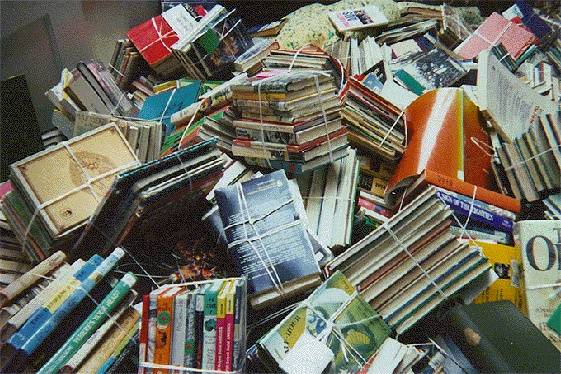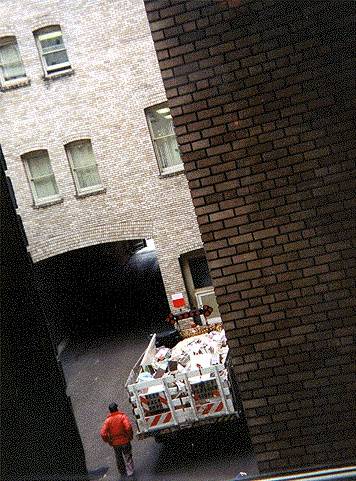Ken Dowlin: Book Dumper: Difference between revisions
No edit summary |
No edit summary |
||
| (One intermediate revision by the same user not shown) | |||
| Line 1: | Line 1: | ||
'''<font face = Papyrus> <font color = maroon> <font size = 4>Historical Essay</font></font> </font>''' | |||
''by Nicholson Baker'' | |||
[[Image:tendrnob$dumped-library-books.jpg]] | [[Image:tendrnob$dumped-library-books.jpg]] | ||
| Line 26: | Line 30: | ||
[[WEEDS |Prev. Document]] [[Satanist Curses High-Rise |Next Document]] | [[WEEDS |Prev. Document]] [[Satanist Curses High-Rise |Next Document]] | ||
[[category:TenderNob]] [[category:Civic Center]] [[category:1990s]] [[category:Earthquakes]] | [[category:TenderNob]] [[category:Civic Center]] [[category:1990s]] [[category:Earthquakes]] [[category:Reclaiming San Francisco]] | ||
Latest revision as of 20:17, 21 November 2021
Historical Essay
by Nicholson Baker
A closeup of some of the books going to the dump during the purge of hundreds of thousands of books from the library.
Photo: anonymous librarian
He has been telling us all along what he's been doing, it's just that we haven't quite understood him. In August of 1992, he introduced the concept of "leveled access" in the humanities to the San Francisco Planning Commission. "Leveled access" involves offering the public, in Mr. Dowlin's words, "a large, generally accessible collection that is designed essentially to be current material--if you will, a mass selection." He has throttled the book budget in math, biology, and literature, while spending far too much money on computer hardware, but he is famous for that, and people with similar enthusiasms are being hired by library boards all over the country. A library director who observed Mr. Dowlin in Colorado told me: "Ken Dowlin for me was a symbol of what not to do. The collection suffered under him." The unfair but widely circulated verdict on his tenure at the Pikes Peak Library System in Colorado Springs was: "Not one book was bought under Ken Dowlin." So not enough books were bought. But what we didn't quite grasp, what is so bewildering and unthinkable, is that, aside from his almost commonplace habit of wasting money on technology, which we all do from time to time, he wanted to damage, to downsize, what had been achieved, at considerable expense, by his predecessors. The staff understood, though. On December 6, 1989, William Ramirez, who was then Chief of the Main Library, wrote a memo for the file describing staff concerns over the events that followed the earthquake. Staff members, he wrote, "believe that current and planned actions will: Decimate the collection [through] weeding, discarding materials from the collections -- both circulating and reference which make this library unique." The staff believes that these actions will, Mr. Ramirez went on, "move us in the direction of changing this library from a strong, reference, research resource and service center to an undistinguished 'popular library.'" That was in 1989. Mr. Dowlin, who spent six years in the Marine Corps before a part-time job at the wheel of bookmobile diverted his interest toward library administration, was predictably unfazed by William Ramirez's report. He has stuck to his plan and he has stuck to his post. It is now 1996, and the books we pay him to protect are still leaving the shelves.
For in addition to the regular pickups, there was an earlier period of massive book-dumping, during Ken Dowlin's reign, and nobody outside the library knew about it, and the staff couldn't stop it. In October of 1989, there was an earthquake. "The earthquake," one librarian told me, "was the best thing that ever happened to Ken Dowlin." Mr. Dowlin himself said, in a speech at the Annual Conference of the American Library Association in 1992, "I can tell you what happens when you get an earthquake that puts five hundred thousand books on the floor. It's a perfect opportunity to rearrange them."
Rearrange them he did. He merged the old Literature and History department and folded it in with most of Science, despite staff protestations and petitions, creating a large catchall category that is now called General Collections and Humanities and is on the third floor of this building. He put cell biology, tree books, sports, Elizabethan poetry, cookery, model trains, and pets all in the same group, I believe, because they represented to him the old-fashioned library of knowledge, with its space-intensive storage needs, its vexingly long-lived book collection. If he collapsed three or four departments into one, they would necessarily take up less mental room and could be budgeted accordingly. Following the earthquake, Mr. Dowlin kept the library closed for two and a half months in order to complete this reorganization, even though his staff told him that they were prepared to open much earlier. Meanwhile large numbers of books were moving all over the place. The ones that had never been entered into the computer were taken to a room in the north wing, on the third floor, and every department was asked to go through these NOFs, as they were called, which stands for Not On File, and make decisions about whether they ought to be kept or withdrawn. (Withdrawn, by the way, is a confusing word: it means, withdrawn from circulation; thrown away or sold or given away.) For a brief time post-earthquake, according to one eye-witness, the DPW trucks were leaving with loads of books every day. A branch information memo, dated December 7, 1989, advised: "There will be no discard pick-ups until the discard room at the Main Library can be cleared. It is so full it has become a fire hazard." Here again, what happened can not properly be described as weeding, unless one can be imagined weeding at the helm of a bulldozer. After much discarding and transferring to remote storage, the remaining NOF books sat in boxes in what came to be known as the Deselection Chamber. They sat there for about five years, totally inaccessible, as the boxes sagged and collapsed, and the bindings within gave way. It is my belief that Mr. Dowlin wanted them to be injured, so that when they were eventually inventoried, they would have to be tossed out based on their condition. Also, if you keep a book out of circulation, you can claim that nobody wants it, because nobody has taken it out.
He could have had them reshelved, of course, but he didn't. I don't think he wanted them in his library. He had already signalled his intention before the earthquake, when he told a reporter for the Bay Guardian that he planned to clean out what he called the "Augean stables" of the library. King Augeus, remember, had a problem with a backlog of ox-dung, and Hercules cleverly managed this situation by redirecting the flow of a convenient river. Mr. Dowlin envisions himself, with fetching modesty, as the Hercules of the Electronic Library, and one of his first labors was to redirect the river of Federal earthquake money in order to cleanse the dun-colored books from his stalls. The damage to the stacks was not structural; nonetheless Mr. Dowlin made the most of it. The FEMA, or Federal Emergency Management Agency, grant application that he prepared requested money for sensible things like physical repairs to the stacks, rebinding, and fixing a gas line. But he also solicited FEMA money for (and I'm quoting the minutes of a Library Commission meeting here) "staff costs for reconfiguring the Main Library," which was part of his reorganizational blueprint and was unrelated to earthquake damage. And he asked FEMA for a new computer system, ostensibly to track earthquake dislocated books as they were moved here and there. FEMA eventually obliged with a large sum. The card catalog was frozen in 1991, and the library got an expensive new computer system some months later. While the budget for automation swelled, money for the low-tech job of collection maintenance--that is, book repair--stayed flat or dropped. Some books were probably repaired and rebound with FEMA money; many more were simply thrown away.
From one point of view, destruction on such a scale makes perfect sense. To a manager who has no personal interest in old books, no conception of why anyone would want to spend his or her life reading and thinking about them--to a manager who believes in the pipeline model of information, and who expects databases and internet access to replace large numbers of monographs in the library of the future, an easy first step to take, even before you buy a database or a CD-ROM jukebox, even before you have digitized one paragraph of text, or designed one web page or had lunch with one multiplexer salesman, is simply to reduce the number of old books you own. You've accomplished something; like an urban renewalist of thirty years ago who had a vision of a transformed city and began by tearing down a neighborhood, you take the first step. The fewer old books you have to scan and catalog and store, the easier it is to live up to the impossible promises you had to make to city officials who gave you the money to buy all the hardware and software you asked for. Mr. Dowlin isn't much of a reader, but he isn't stupid, and when he put his hardhat on and toured the jostled stacks in October of 1989, he felt, I believe, the happy calm of a man who knew that the earthquake was his ticket into the 21st century.
--Nicholson Baker from "Weeds" in Reclaiming San Francisco: History, Politics, Culture (City Lights Books, 1998)
Truckload of books waiting to go to the dump, c. 1992, Old Main Library.
Photo: anonymous librarian


